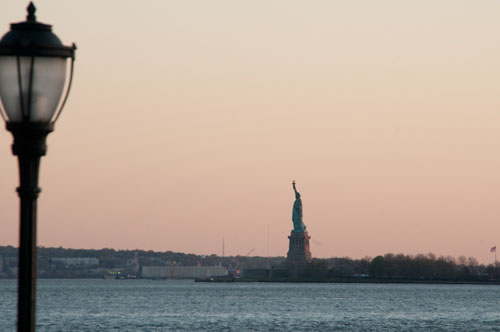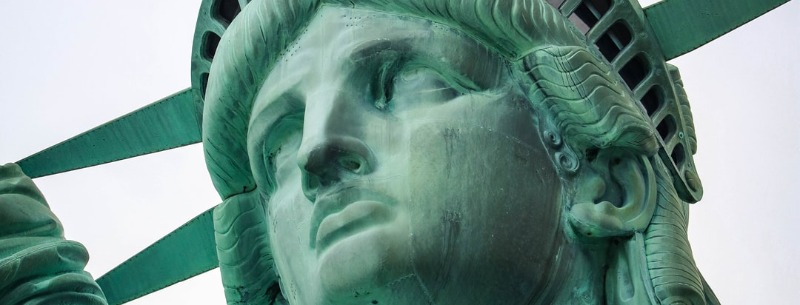Visiting the Statue of Liberty and the Ellis Island Immigration Museum is as educational as it is inspiring. As an added bonus, the ferry trip across New York Harbor offers beautiful views of New York and New Jersey.
The Statue of Liberty, a long-time international symbol of freedom and liberty, is located on Liberty Island. Most tourists only visit the grounds around the statue. With a little extra planning, you can go into the museum and pedestal levels of the statue, and even up into the crown as outlined below.
Ellis Island, once the nation’s foremost federal immigration station, is now the site of the Ellis Island Immigration Museum. Over 40% of Americans today can trace their ancestry through Ellis Island.

of freedom and democracy!
Hours
- Ferries depart Manhattan from 8:30 am to 4:30 pm
- Last ferry departs Liberty Island at 6:15 pm
- Closed on Christmas Day
If you want to visit both islands, make sure you are on a ferry that departs by 2:00 pm (and note that the security line before boarding the ferry can take 1 to 2 hours).
Getting There
Visiting the Statue of Liberty and Ellis Island requires taking a ferry from either New York or New Jersey. The ferry from New York leaves from Battery Park at the southern tip of Manhattan. The ferry first stops at Liberty Island, where the statue is located, then Ellis Island, where you will find the Ellis Island Immigration Museum.
Tickets can be purchased online in advance through Statue Cruises or you can purchase them at Castle Clinton National Monument, located near the Ferry Terminal.
Directions to the Ferry Terminal/Castle Clinton
- By subway, take the 4 or 5 train to the Bowling Green Station. Walk South to Battery Park. Follow signs for Castle Clinton and Statue of Liberty Ferry. You can also take the 1 train to South Ferry (the last stop) or the R/W train to Whitehall Street.
- By bus, take the M1, M6, or M15 bus to South Ferry.
Prices and Ticket Purchasing Information
Admission to the Statue of Liberty grounds and the Ellis Island Immigration Museum is technically free, but you have to purchase a ferry ticket to get there. One fee includes all three rides – to Liberty Island, from Liberty Island to Ellis Island, and from Ellis Island back to Manhattan.
Ferry Ticket Prices
- Adults: $17
- Seniors (62 and over): $14
- Children 4-12: $9
An audio tour is included.
Options for Purchasing Tickets
- You can purchase round-trip ferry tickets upon arrival at the Castle Clinton National Monument in Battery Park (near the ferry terminal).
- You can purchase a Reserve Ticket online in advance. You will have a specific day and time to arrive at the security screening zone, reducing the amount of time you wait in line. Purchasing a Reserve Ticket also gives you the choice of adding a Monument Access Pass and/or a Crown Ticket (see below).
Click here to purchase a Reserve Ticket online with Statue Cruises.
Add a Monument Access Pass
A Monument Access Pass allows entry to the museum gallery and pedestal observation levels of the Statue of Liberty. It is available at no extra cost when purchasing a Reserve Ticket online from Statue Cruises. The pass can also be picked up for free at the ticket booth at Castle Clinton on a first-come, first-serve basis. It is not available once you get to Liberty Island.
Add a Crown Ticket
Visitors can now access the crown of the Statue of Liberty. A crown ticket is available for an additional $3/ticket when you purchase a Reserve with Crown Ticket online through Statue Cruises. Crown Tickets sell out fast, even months in advance. Check the Statue Cruises website for availability and reserve early.
Read more about ticket options and prices.
Tips for Visiting the Statue of Liberty
Visiting the Statue of Liberty and Ellis Island is not a quick trip. Seeing both islands takes at least 3 hours, not including security lines. You should plan to depart the ferry terminal no later than 2 pm if you want to see both.
Every visitor must go through a security checkpoint before boarding the ferry. You will likely have to wait in line for 1 to 2 hours depending on the crowds.
Statue of Liberty Facts
- Date: Built in France in 1884, reassembled in its current location on Liberty Island in the United States in 1886
- Materials: Constructed of copper on the outside with an iron skeleton on the inside and resting on a granite base
- Height: The statue alone is 151 feet tall. The total height of the monument (including the statue, base, and pedestal) is 305’1″ from the ground to the top of the torch.
- Architects: French architect/sculptor Frederic-Auguste Bartholdi designed the statue and American architect Richard Morris Hunt designed the pedestal
- Engineer: The iron frame was designed by French civil engineer Gustave Eiffel
- Style: Neoclassical
- Formal Name: Statue of Liberty Enlightening the World
History of the Statue of Liberty
The iconic statue of a robed woman holding a torch in an outstretched arm was a gift from the people of France to the people of the United States. It was meant to commemorate the friendship between the two countries and also mark the 100-year anniversary of American Independence (although it arrived almost a decade late due to fundraising and other difficulties).
The statue was manufactured in Paris, France, and then disassembled into 350 pieces and transported by sea to New York. It arrived in 1885 and was reassembled over 4 months after the pedestal was complete.
The people of France donated the funds for the statue. The Americans agreed to build the pedestal, mostly with money raised by newspaper publisher John Pulitzer. On October 28, 1886, it was formally dedicated by President Grover Cleveland.
The statue, designed by Frederic-Auguste Bartholdi is made of copper skin on the exterior and is supported by an iron framework on the interior. To create the copper surface that the statue is made of, Bartholdi hammered out each piece of copper to 3/32 of an inch in thickness.
The iron framework designed by Gustave Eiffel (co-designer of the Eiffel tower) supports the copper exterior.
The statue is very symbolic. Her right hand holding a torch signifies the enlightenment of the world. The seven rays on her crown represent the seven seas and the seven continents. The chains lying at her feet symbolizing her escape from tyranny.
The inscription on the tablet she holds in her left-hand reads “JULY IV MDCCLXXVI” (July 4, 1776, in Roman numerals), the date the United States declared independence.
The statue faces southeast, visible to the over 12 million immigrants who sailed past the statue on their way to Ellis Island between 1892 and 1924.
